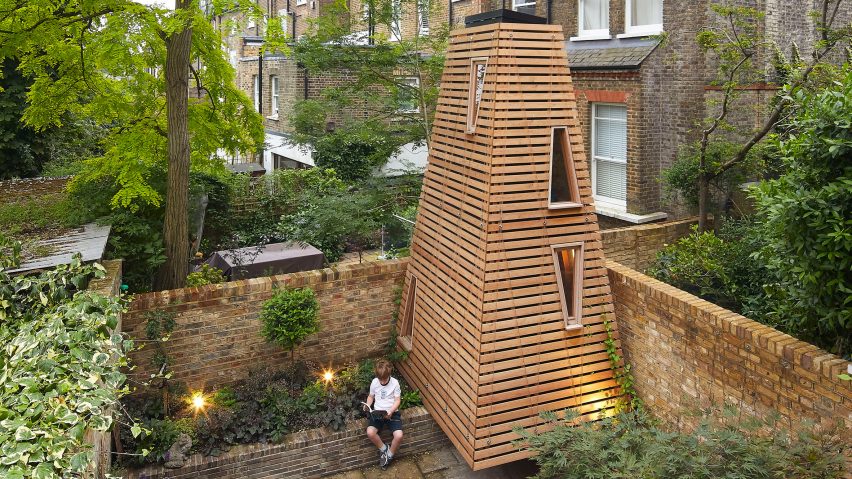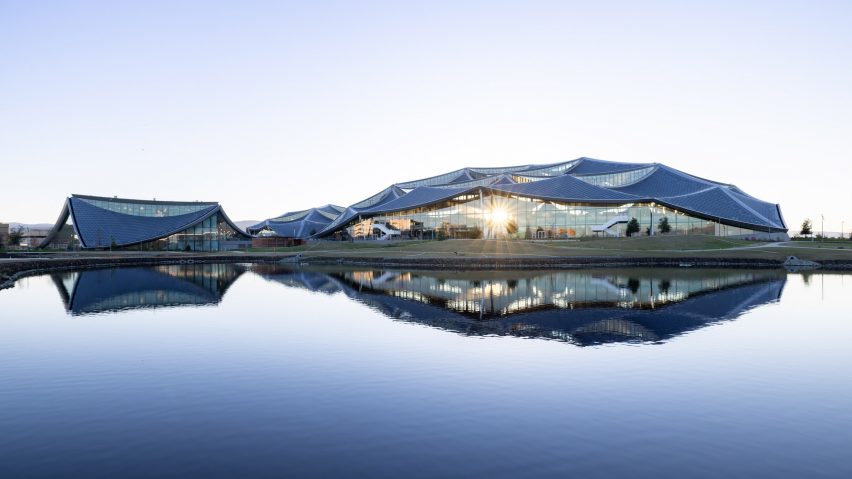Architects Declare hits back over “failure” claims
The UK chapter of Architects Declare has responded to a recent opinion piece published on Dezeen that argued the climate network has been a “failure”.
In a statement provided to Dezeen, which is published below in full, the steering group for UK Architects Declare stated that the opinion piece contained “numerous flaws”.
Written by Chris Hocknell, director of UK sustainability consultancy Eight Versa, the original article claimed that Architects Declare’s commitments were unrealistic and that many architecture studios which signed up to the initiative have failed to implement its aims.
“While bold and splashy commitments may make for impressive LinkedIn posts, failing to meet those targets undermines faith in the power of commitments and discourages others from taking the collective action required to effect real change,” Hocknell wrote.
“Surprisingly defeatist”
In its response, UK Architects Declare said: “In summary, on these key questions, we agree that we need to accelerate the pace of change and that there are too many firms continuing with business as usual or very close to it.”
“Where we disagree is in the implied assertion that the solution is to return to conventional approaches to sustainability,” it continued.
The group argued that “a target-setting and compliance approach would be mistaken”, suggesting that such mechanisms have proved ineffective in combating climate change.
It also claimed that Hocknell’s argument that many of the Architects Declare commitments are outside of architects’ control is “surprisingly defeatist”.
Commitments made in good faith “admirable in our view”
However, the statement said the steering group “partly agree” that some studios are not implementing Architects Declare’s commitments.
“We haven’t seen the level of change necessary to match what the science shows is required […] but it’s absurd to suggest that lack of full commitment invalidates the whole initiative,” it added.
Hocknell’s piece also argued that “no commitment is often better than a failed one” when it comes to climate-target setting.
“We fundamentally disagree,” the UK Architects Declare response said. “As long as the commitment is made in good faith and followed up earnestly, that is admirable in our view.”
“There is clearly a long way to go in little time”
Architects Declare was established in May 2019 by an initial group of 17 Stirling Prize-winning UK studios. It now has nearly 1,300 signatories, with thousands more across 28 different countries.
It is based around pledges to move towards designing buildings and cities that go beyond limiting carbon emissions to having a positive impact on the planet and biodiversity.
Among the 12 Architects Declare commitments are promises to “evaluate all new projects against the aspiration to contribute positively to mitigating climate breakdown”, “accelerate the shift to low embodied carbon materials in all our work” and “include life cycle costing, whole life carbon modelling and post occupancy evaluation as part of our basic scope of work”.
As part of its response to Hocknell’s piece, UK Architects Declare listed its achievements, including the publication of resources on implementing the pledges, a book on regenerative design co-authored by a steering-group member and attempts to influence Royal Institute of British Architects (RIBA) and Council on Tall Buildings and Urban Habitats policies.
“There is clearly a long way to go in little time, but there is much greater action on regenerative design now than there was four years ago, and a greater understanding of the shortcomings of conventional sustainability,” the statement said.
“We think it’s fair for AD to be credited with some of that shift – and to be constructively challenged and supported in reaching further.”
Last year, the design industry followed architecture in establishing the Design Declares campaign, with eight founding signatories.
The full response from UK Architects Declare is below:
We would like to respond to the recent article that made a number of assertions about Architects Declare. Its numerous flaws could have been addressed had the author contacted us to shape a constructive piece on how architects can offer their skills, experience and commitment to tackle the climate and biodiversity emergency. Nevertheless, we are keen to clarify where we agree or disagree with the piece and correct the record.
Firstly, we should point out that Architects Declare (AD) is an international movement with active groups in 28 countries and is part of the wider Built Environment Declares. The article focused on us in the UK without making that distinction – presumably, the author’s experience is with UK practices – and we hope that readers outside the UK will not feel that the criticism aimed at us (incorrectly, as we show) was an attack on them also. We are responding as the steering group for UK Architects Declare.
We welcome reasoned discussion. Indeed, effective dialogue has been one of AD’s aims from the start. AD has a well-developed theory of change, drawing on solid research in systems thinking and how best to move the current system – in this case, away from a failing assumption that improved sustainability will solve the emergency over time to one of regenerative design that addresses the emergency head on. We say more on that below, but it’s important to recognise that the original article spoke from within the current sustainability paradigm.
We address the article’s key assertions, which were:
1. That we should set “realistic, achievable and accountable” targets and have a means by which these are enforced
As a theory of change, this is almost identical to what’s been advocated for the last 30 years as sustainability and has not got us anywhere near to where we need to be. The latest IPCC report, AR6 Synthesis Report: Climate Change 2023, is a stark reminder of the urgent need for action. Global greenhouse gas emissions have continued to increase and we need to be doing much more, much faster, or we risk not being able to limit warming to 2 degrees Celsius, let alone 1.5 degrees Celsius. This is why AD’s theory of change builds on Donella Meadows’ system thinking, which asserts that the most influential way to change a system is by intervening at the level of the paradigm or mindset that determines how it behaves. The second-most effective leverage point is to change the goals of the system. The transition we need is far more than some simple industrial shift focused almost exclusively on carbon. What’s required is a broader cultural shift that extends perspectives beyond carbon to much wider issues, including the whole web of life, and beyond a limited ambition of mitigating negatives towards optimising positives.
We believe a target-setting and compliance approach would be mistaken for AD. The system change required is difficult to achieve simply working at that level, even at scale. And to monitor 1,200-plus signatories would mean AD charging significant subscriptions and taking on a policing role. This would undoubtedly put off large numbers of would-be signatories which, in turn, would reduce our influence when making the case to government on the role that it needs to play.
2. That a number of the practices are not implementing AD’s declaration points
On this point we partly agree. We haven’t seen the level of change necessary to match what the science shows is required. We have seen a range of responses among AD signatories.
Some have adopted the spirit of the declaration, implementing new procedures throughout their companies, including new positions for heads of regenerative design. Some have signed and are now striving to catch up – and we’re working to assist them with a range of resources. Others have signed up and taken little or no action. While the latter category is disappointing, having more signatories signals the required direction of change and makes the collective voice more influential, and we hope that, in time, all signatories will be encouraged and enabled (internally by staff, externally by broader cultural and professional shifts) to engage more meaningfully.
Obviously we would prefer all practices to be in the first category but it’s absurd to suggest that lack of full commitment invalidates the whole initiative.
3. That some of the declaration points are outside an architect’s remit
This statement is surprisingly defeatist. Perceived limits to people’s agency are a major part of why there has been so little progress, and this includes architects as much as other professions and communities. Where we see that urgent change is necessary, but feel this to be outside our control, we need to find ways to extend our agency through broader industry collaboration and through pushing for higher-level systems change.
4. That making no commitments on climate is better than making a commitment and failing to meet it
We fundamentally disagree. The changes necessary to address the planetary emergency are currently well beyond even the most progressive practices, and there is no built-environment company we’re aware of that could be described as fully regenerative. To suggest that making no commitment is better than failing to meet a stretching one is a counsel of despair. Anyone who advised a business not to bother if they couldn’t see a way to make progress would be doing a very poor job.
Many of the practices that signed the declaration did not at that time know how they would address its challenges, but making a commitment to try is the important first step. As long as the commitment is made in good faith and followed up earnestly, that is admirable in our view. Sharing knowledge of our successes and failures on that journey is part of the process and key to improvement.
In summary, on these key questions, we agree that we need to accelerate the pace of change and that there are too many firms continuing with business as usual or very close to it. Where we disagree is in the implied assertion that the solution is to return to conventional approaches to sustainability. We would welcome an informed critique of our theory of change and can provide the key sources for anyone wishing to do that.
The article also made some confused comments about AD’s interaction with government, which overlook the role governments could and should play in accelerating the shifts we need. Developers operate within an economic system and if that system is leading to collapse then it’s right that governments should be expected to change it. There are inspiring examples like doughnut economics that AD has advocated, and there are examples of governmental bodies are already getting on board with that shift.
Have we achieved what we set out to do? Even a brief account of what AD has done and continues to do (which the article fails to even attempt) will suggest the progress we are making and the direction we are moving in.
- Many signatory architects described our first event, at which Kate Raworth and Jeremy Lent spoke, as a turning point in their careers
- And many people – steering group members and other volunteers from signatory practices – worked hard to produce AD’s extensive and well-received Practice Guide and a comprehensive series of Action Practice Masterclasses based on that: all specifically structured to help practices progress with their commitment to the declaration. We are collaborating again to include regenerative design guidance
- One of our steering group members has co-authored a book exploring the philosophical shifts and practical steps involved in moving from “sustainable” to “regenerative”
- We’ve organised many events with high-profile speakers on topics such as new economics, long-term thinking, company transformation, climate justice and regenerative materials
- We work with others to ensure the best reach of our efforts and expertise – not least with the RIBA to launch our joint Built for the Environment report and summit ahead of the COP26 summit held in the UK
- And we challenge others, not just government, where they can help change the goals of the system: for example, making the case to the RIBA that the strategic mission of the profession needs to be updated and seeking to engage the Council on Tall Buildings and Urban Habitats on a transformative new mission
There is more work underway, both to help our signatories meet the challenges of the declaration while improving their businesses, and to make strong calls on those who can do what architects cannot do alone: change the system that perpetuates the planetary emergency to one that addresses it. And we share progress and problems with other declare groups here in the UK and around the world, with regular international gatherings on Zoom.
All of this gives us, our partners and our signatories strength in pushing ahead. There is clearly a long way to go in little time, but there is much greater action on regenerative design now than there was four years ago, and a greater understanding of the shortcomings of conventional sustainability. We think it’s fair for AD to be credited with some of that shift – and to be constructively challenged and supported in reaching further.
Importantly, our declaration draws attention, front and centre, to what is needed across the built environment and its stakeholders. What is needed is not merely a continuation of conventional sustainability but striving to change the mindset and the goals of the system.
From the steering group for UK Architects Declare: Duncan Baker-Brown, Julia Barfield, Alasdair Ben Dixon, Mandy Franz, Tara Gbolade, Tom Greenall, Kevin Logan, Anna Lisa McSweeney, Ken Okonkwo, Anna Pamphilon, Michael Pawlyn, Craig Robertson, Zoe Watson, Andrew Waugh and Anna Woodeson.
Some of the AD Steering Group with speakers at our November 2022 ‘Building Justice: Crisis Solutions’ event.”
The photo, showing members of the Architects Declare steering group together with speakers at a November 2022 Architects Declare event, is courtesy of UK Architects Declare.





